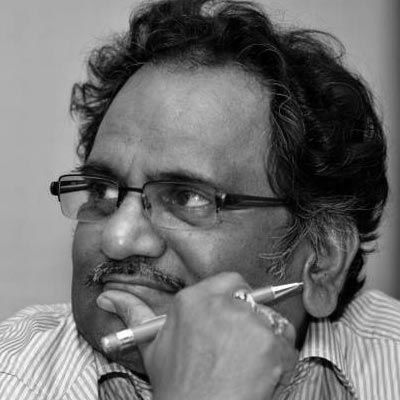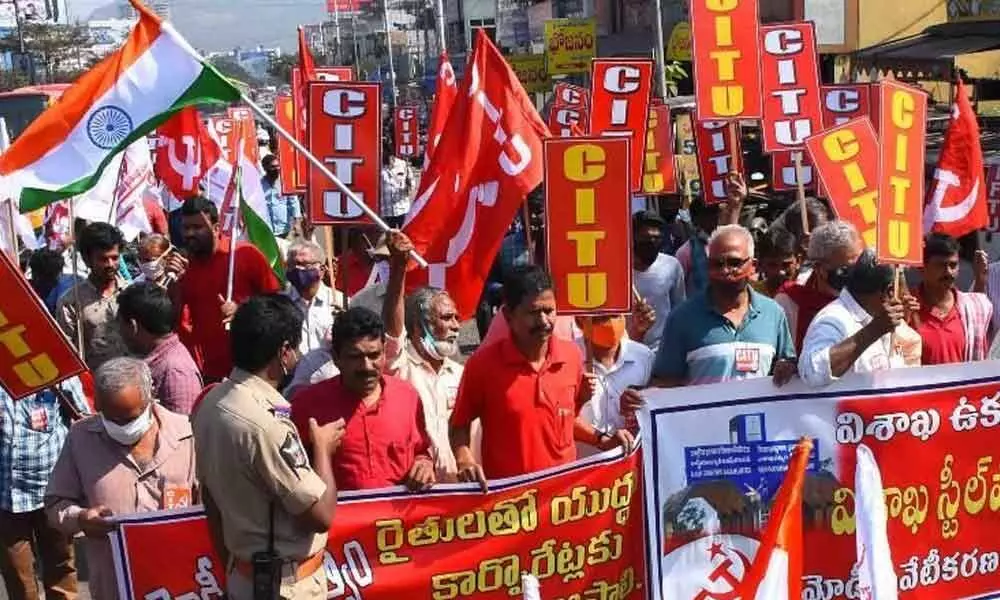Live
- Stokes motivates his team to put in extra effort, says England pacer Potts
- From overcoming setbacks to leading India in U19 Women’s Asia Cup, Niki Prasad's amazing journey
- Constitution debate: PM Modi hails 'Nari Shakti'; makes strong pitch for 'United Bharat’
- Bihar: Inquiry initiated against principal who went to buy veggies during school hours
- TN: DMK postpones executive meet due to heavy rains & Parliament session
- Porous silicon oxide electrodes can fix durability issues in batteries: Researchers
- Jalandhar civic polls: AAP promises launch of 100 e-buses, round the clock water supply
- Economic upliftment of rural women is priority of Tripura govt: CM Saha
- Rajmata Jijabai Trophy: Manipur move to top of the table, T.N register first win
- Italian envoy Baroli hoping to strengthen ties with India through football
Just In
Vizag Steel Plant: A victim of neglect over decades


A victim of neglect over decades
Visakhapatnam, the steel city (Ukku Nagaram, the name assumed because of steel plant) has woken up to this decision of the Centre without consulting anybody, its people, employees of VSP and the trade unions came together and voiced together for withdrawal of the decision to disinvest the Government’s share in VSP
The Centre's plan to sell away the Navratna public enterprise - Vizag Steel Plant (VSP) will be a big blunder. The time has come for the two Telugu state people to unite and fight for protection of the icon of Telugu self-respect - VSP - for which there were agitations in all the districts of combined Andhra Pradesh in 1970s under the name "Vishakha Ukku Andhrula Hakku" for which 32 agitators laid down their lives.
In 1965, an Anglo-American consortium certified that Visakhapatnam was a suitable place for a steel plant. But PM Indira Gandhi rejected it in 1966 leading to a strong agitation. Veteran freedom fighter Tenneti Viswanatham led the movement and T Amritharao took to indefinite hunger strike. On November 1, 1966 police opened fire killing nine persons. In 1970, Indira Gandhi declared the establishment of the VSP and she came to the city to lay its foundation in 1971.
When the Centre sells this unit, how does it value the 32 lives and the donation of 6,000 acres of land by local Kurupam Jamindars in 1970 and 16,000 acres of land allocated by AP Government at throw away price? The Government, the donors and the people were expecting that it would help all round development of the state and generate employment for many.
The plant had increased steel production from 3.4 million tonne to 7.3 million tonne with its own funds and with bank loans reflecting its financial strength. While the Centre's initial investment was around 4,900 crore, the RINL has paid back Rs 43,000 crore to both the Centre and Andhra Pradesh for various taxes and dividends so far. Which means the Centre did not suffer any loss but remained in profits, though it did not give single paise in the last 25 years.
It has no moral right to blame that VSP should be sold out because of its losses. Two main reasons for the losses are that the VSP had to bear the burden of interest for bank loans it took for increasing the production and had to purchase thousands of tonnes of iron ore every day for higher cost as the Centre did not allocate mines to its own unit.
The Union Cabinet had cleared the privatisation of Rashtriya Ispat Nigam Ltd (RINL), as per the tweet on February 3 by the Secretary of DIPAM (Department of Investment & Public Asset Management) Tuhin Kanta Pandey. DIPAM means lamp, but this tweet if DIPAM will put off lakhs of 'dipams' in lakhs of families in Visakha.
Tuhin Kanta Pandey said that the RINL strategic sale proceeds would be part of the disinvestment target for next fiscal year starting from April 1. "Cabinet Committee on Economic Affairs has, on 27th Jan 2021, given in principle approval for 100 per cent strategic disinvestment of Government of India shareholding in Rashtriya Ispat Nigam Limited RINL along with management control by way of privatisation". Strategic disinvestment is a 'strategic name' for selling off the PSU to crony capitalists.
Visakhapatnam, the steel city (Ukku Nagaram, the name assumed because of steel plant) has woken up to this decision of the Centre without consulting anybody, its people, employees of VSP and the trade unions came together and voiced together for withdrawal of the decision to disinvest the Government's share in VSP.
The Kurupam Zamindars have donated 6,000 acres of land in 1970 for Vizag Steel Plant. Then a new company called Rashtriya Ispat Nigam Limited (RINL) was formed on 18 February 1982. Thus the Visakhapatnam Steel Plant was separated from SAIL and RINL was made the corporate entity of Visakhapatnam Steel Plant in April 1982.
On 20 May 2009, Prime Minister Manmohan Singh launched the expansion project of Visakhapatnam Steel Plant from a capacity of 3.6 MT to 6.3 MT at a cost of Rs. 8,692 crores. But the investment was revised to 14,489 crores with classification - Expenditure for the financial year 2009-10 was Rs 1840 crores, Rs 5883 crores since inception of the project and total commitment, including enabling works, steel procurement, consultancy, spares, etc. was Rs 11,591 crores as of 25 March 2010.
The VSP is the first shore-based integrated steel plant in the entire country. It has 16,000 permanent employees and around 20,000 contract workers and provides indirect livelihood to 65,000 people. Five lakh people, a quarter of population of Visakha depend on this factory, for which the then Prime Minister laid foundation stone in 1977. It began production in 1992.
The steel plant has a capacity of 7.3 million tonnes per annum with two subsidiaries – The Orissa Minerals Development Company Ltd (OMDC) and The Bisra Stone Lime Company Ltd (BSLC) – and runs RINMOIL Ferro Alloys Pvt Ltd, an equal joint venture with Manganese Ore (India) Limited Company (MOIL) and RINL Powergrid TLT Pvt Ltd, also an equal joint venture with Power Grid Corporation of India Ltd. In 2020, under the directions of the Union Steel Ministry, RINL signed a Memorandum of Understanding (MoU) with South Korean Steel Corporation POSCO company to set up a joint venture on the plant's land in Visakhapatnam.
The Central government should take the responsibility for starving the VSP by not allocating mines as captive mines for uninterrupted supply of iron ore. In spite of Union's continuous demand for allocation of captive mines over a few years, there was no response from the Centre and state failed to build pressure to secure allocation of mines, which could have drastically reduced the losses. While allocating the mines to private companies and not giving any mine to its own unit has surprised many.
One allegation of the Centre is that the VSP is suffering losses and it cannot afford losses anymore. RINL has incurred net losses worth Rs 1,321 crore in 2017-18 and a net profit of Rs 96 crore in 2018-19. "It is only in recent years that the plant was incurring losses, mainly owing to the crisis in the steel industry. Another main reason is due to the non-allotment of captive mines in spite of numerous requests. The plant can expand and revive on its own with minimal government support," said the union leaders.
Though having an installed capacity of 21 million tonnes per year, the Visakhapatnam Steel Plant has presently been operating with a production capacity of only 7.3 million tonnes. The basic reason for this underperformance of the plant is lack of raw material. Unlike Steel Authority of India Limited (SAIL), Tata Steel, Jindal Steel and other such plants, the VSP does not have its captive iron ore mine. It has been depending on the supplies from Bailadila mines being run by the National Mineral Development Corporation and importing coking coal from Austria. The other steel plants have their own captive mines, they are able to get the iron ore at a cost of ₹1500 per tonne, whereas the RINL was spending ₹7,000 per tonne. VSP requires 20,000 tonnes every day, for which they are compelled to purchase at higher price and that is resulting in huge losses to the company.
Instead of facilitating the supply of raw material i.e., allotting captive mines, the Government has referred it in 2003-04 to the Board for Industrial Finance and Reconstruction (BIFR) for winding up the company due to losses. Then there was a massive agitation by the workers, employees and the people, and the promise of the workers to work hard and turn the plant into profits within two years. The VSP was saved as it could make some profits.
The steel plant has a highly valuable asset in the form of huge tracts of land of 22000 acres. At the present market value, each acre costs around ₹5 crore. So, the land value itself is more than ₹one lakh crore. The Centre is likely to sell this prime property to private parties for a song.
The workers gave some more details which reveal the real reasons for the status of VSP. "It must be recalled that the Central Government has invested Rs 4,900 crore into the plant since its inception but the state government had made an investment of about Rs 42,000 crore". The Government is marching ahead with its 'disinvestment' plan to make Rs 1.75 lakh crore in this financial year.
AP CM requested the Centre not to sell the VSP, while pointing out that RINL achieved its highest ever capacity utilisation of 6.3 MTPA against the capacity of 7.3 MTPA in December 2020, posting a monthly profit of close to Rs 200 crore.
(The writer is Professor of Law, Madabhushi Sridhar AcharyuluBennett University and former Central Information Commissioner)

© 2024 Hyderabad Media House Limited/The Hans India. All rights reserved. Powered by hocalwire.com






